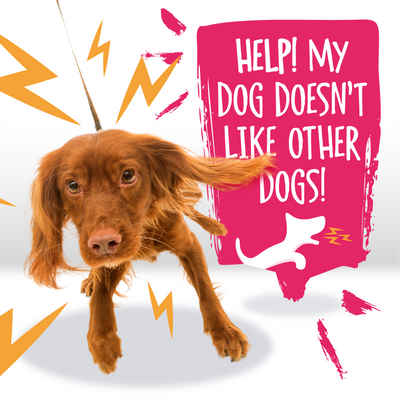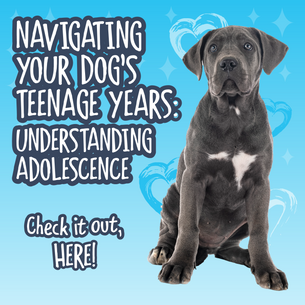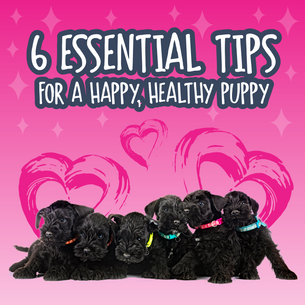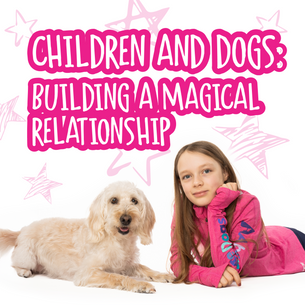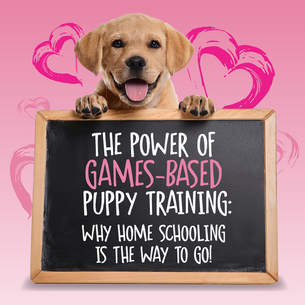Did your dog owning dream start with a vision of stress-free walks, doggy play dates and seeing your dog having endless fun with other dogs in the park?
Perhaps you had a dream of a dog who loves every other dog they meet, greets other dogs appropriately and enjoys nothing more than some energetic rough and tumble with their canine companions.
Popular culture reinforces this idea that all dogs should be sociable and friendly with one other. Think Lady and the Tramp.
But what if your reality is somewhat different?
Perhaps you have a dog who barks and reacts when they see another dog, or who actively dislikes other dogs. Maybe you spend your walks avoiding other dog walkers, jumping behind hedges, walking at unsociable hours, and wondering what happened to that dream.
If your dog struggles with other dogs, you probably see ‘sociable’ dogs everywhere you look! It can be pretty disheartening. It can make your walks stressful. You may even be wondering what you did wrong.
If that’s you, we want to tell you two very important things:
- Firstly, you are not alone.
- Secondly, your dog doesn’t need to be friends with lots of other dogs to be happy and fulfilled.
Does that come as something of a relief?
You are the very best owner for your dog.
You know your dog better than anyone else. If your dog is telling you, in whatever way, that they are not comfortable or equipped to play or interact with other dogs, that is totally OK! They don’t have to!
Let’s dive into 5 things you need to know about Dog Dog Interactions which will bust some myths and demystify that all-important interaction chain between dogs.
1. The Truth about Dog Socialisation
The truth is that dogs don’t need to play and interact with every other dog they meet when out and about. In fact, there is much more benefit in teaching your dog how to be what we like to call “dog neutral”, which simply means getting your dog to ignore other dogs.
Does that sound a bit controversial?
You may find that idea to be completely at odds with everything you’ve ever learned or been told.
Perhaps when you brought your dog home you were introduced to the idea that to socialise your dog, you need to take them out and make sure they meet every type of person, interact with lots of different dogs, and experience every possible scenario life might throw at them, as early on as possible in that crucial ‘socialisation window’.
You were told that your dog must see the jogger, the vet, the postman, the man who walks down the street wearing a fluorescent jacket and a wizard hat! (Be honest, did you go out looking for the weirdest looking person for your puppy to see?!)
As part of that quest to smash through your puppy’s socialisation checklist, you were more than likely told that your dog needs to make friends with other dogs. If your dog is less sure around other dogs, you’ve probably been told that they aren’t ‘properly socialised’, and that they need to learn from other dogs. The more exposure, the better their etiquette around other dogs will become.
Familiar?
But maybe you’ve tried that, and it didn't end up going so well. Maybe instead of getting ‘better’ around other dogs, your dog has actually become more reactive to dogs, or is getting into more scuffles. Perhaps you had a super sociable puppy who would throw themselves into play with any other dog you encountered, and as they have matured their interactions with other dogs have become less positive.
Dogs learn from each other
There is no question that dogs can learn from other dogs.
Some dogs can provide you with a really brilliant buddy for your dog – a doggy pal who can guide them along the right path and help them make the right choices.
However, your dog can just as easily learn less desirable or inappropriate behaviour from dogs that they interact with, or have bad experiences that change their view of other dogs and make them wary or fearful.
2. It Just Takes One Bad Experience with Another Dog…
This is where that traditional approach to socialisation, which relies on exposure to lots of other dogs, can go really wrong. It is what we would call training IN the situation, before your dog has the skills and knowledge for that situation.
Of course your dog may have some great experiences, but they may also have some very challenging ones. Statistically, they are more likely to have bad ones.
Dogs (like humans) are motivated by the avoidance of pain, discomfort or fear, and the seeking out of pleasure, or what we might think of as positive experiences. In a battle, avoiding pain would win. So what does that teach us about socialisation? It teaches us that one bad experience has far more significance than a hundred good ones.
Yet the more you expose your dog to, even when you are doing so with the very best of intentions, the more chance there is that they are going to have one or more bad, or fearful, experiences.
Did you know that in order to outweigh that one bad experience you would then need to ensure they had another hundred good ones?
Yet in trying to find those hundred good ones, you're going to bet that at least one of those is bad too.
Do you see how easily this can go wrong, even when your motivation is to give your dog the very best start in life?
Imagine this scenario (perhaps it’s familiar)…
You want your new puppy to socialise with other dogs, so you take them out and introduce them to every dog you come across.
At some point, they are going to try and interact with a dog that doesn't like them. That dog might growl, or snap, or do something else that worries your pup and makes it a negative experience for them. Your instinct at this point might be to find lots more friendly dogs to offset that bad experience, but in doing so you meet a few more who aren’t so friendly, or don’t think much of puppies, and all of a sudden you have clocked up five bad experiences.
Those bad experiences can really impact your puppy’s view of the world and of other dogs.
You might have an extremely optimistic, resilient puppy who takes these bad experiences in their stride. Or you might find that each bad interaction chips away at your dog’s optimism and makes them a little more pessimistic and a little more reactive to other dogs.
Consider another scenario...
You allow your super sociable puppy to interact with every other dog and they learn that other dogs are amazingly exciting.
As your puppy grows, you become a little more wary of allowing them to interact. Perhaps they are bigger than many of the other dogs you meet, or more boisterous, and you worry they will accidently do some damage in their exuberance.
Or perhaps as they reach adolescence their recall becomes hit and miss when they are playing with other dogs, so you decide to limit their chances of ignoring you while you fix their broken recall. So you start keeping them on lead and don’t let them play with other dogs as much, which causes them to become frustrated.
Suddenly they are not allowed to greet other dogs, and over time you begin to see your dog start reacting negatively to other dogs and you’re not quite sure why.
Frustration, when coupled with the arousal (increased excitement) of seeing another dog, can very easily flip into fear.
If you have a dog who is already worried about other dogs, whatever the root of that fear, consistent exposure to other dogs is not going to magically make your dog more sociable or reduce their reactivity.
3. Appropriate Conversations with Other Dogs are Hardwired
Dogs are born understanding how to interact with their own species. That’s not something we need to teach them. We call it their interaction chain.
However, appropriate greetings require both dogs to have the skills to be able to have those polite, balanced conversations. If either dog is missing one of those key skills, an interaction between them may not go so well.
Some dogs, much like some people, struggle with certain parts of the conversation because they don’t naturally have all the skills needed to interact appropriately.
Think about a person you know who finds social interactions a little challenging. Perhaps they understand how a conversation should flow, but when they find themselves face to face with a stranger, that conversation is awkward, because they’re nervous or anxious. Or maybe they find themselves unable to get away because they’re not sure how to end the conversation politely.
It’s the same for dogs. While all dogs have a hardwired interaction chain which allows them to have appropriate conversations, some lack the skills to progress from one step of that interaction chain to the next, and so those interactions become awkward or inappropriate. This is determined by the skills your dog currently has, and potentially also by any past experiences which have taught your dog that interactions with other dogs don’t always go well.
If there is a break at any point in the chain, a dog will struggle to interact appropriately.
“My dog is broken?!”
Many dogs have breaks in their interaction chain. We’re going to dive a little deeper into this in a minute. But before we do, we want you to know that all is not lost! If your dog’s interaction chain is broken, it can be fixed. There’s a Game for That!
4. Understanding the Dog-Dog Interaction Chain
1. See / Hear
The first step of the chain is when your dog hears, or more commonly, sees, another dog (this can also apply to other distractions, such as people). The distance at which a dog becomes aware of an approaching dog will vary from one dog to another. If you observe your dog you will begin to notice the point at which they become aware of another dog in the distance.
2. Approach
The next step of the interaction chain is the approach.
3. Nose-to-Nose
After the approach, dogs will naturally greet nose-to-nose.
4. Move to Rear
After a friendly nose-to-nose greeting, dogs should move to the rear for a quick bum sniff!
5. Play or Move On
In an appropriate greeting chain, your dog should then either engage in well-mannered play, or move on completely (disengage from the other dog and carry on with what they were doing before the other dog appeared).
At every transition between one stage and the next in this interaction chain, your dog might move to the next stage, or they may get stuck. Noticing where they get stuck will help you work out where their chain is broken.
What might indicate a break in the chain?
1. See/Hear
Your dog’s chain might be broken right at this very first part of the chain, long before they even interact with the approaching dog. If your dog has a history of unpleasant experiences with other dogs, even the possibility of having to engage with another dog can stress your dog out.
Notice how close the approaching dog is when your dog shows any visible sign of being aware, and being worried or anxious. This could be quite a subtle change in their body language (hesitancy, tail lowered, refusing to move), or it could be much more obvious (barking and lunging). Learn to observe your dog and watch for subtle signs that they aren’t comfortable. Your dog determines how close is too close and how far away is far enough.
2. Approach
If your dog is worried about other dogs, perhaps because of bad encounters in the past, the approach can be really tough.
Dogs don’t like conflict situations. Nobody likes to feel scared, and dogs are no different. If your dog anticipates and predicts the pressure of an interaction they don’t think is going to go well, they are anticipating that negative emotion they felt in the past.
Knowing this, you can understand how seeing a dog a long way in the distance, which gradually gets closer and closer, can build anticipation and make your dog feel increasingly anxious. By the time you reach the other dog, your dog is so stressed that they react straight away.
You might have noticed that a surprise encounter with a dog who suddenly appears from round a corner can go much better, because your dog hasn’t had that build up!
3. Nose-to-Nose
If your dog’s chain is broken during this part of the interaction chain, they will get stuck and be unable to disengage or move away from that interaction and onto the next step. This can be where your dog might get into a scuffle, because they find they can’t get themselves out of a situation that they really don’t want to be in.
4. Move to Rear
If your dog gets stuck here, the tension can build in the same way as if they get stuck at the nose-to-nose part of the chain. Being unable to take themselves out of that situation can create a build-up of stress and fear, which can lead to an inappropriate interaction between the two dogs.
It’s worth remembering that a break in the chain doesn’t necessarily look unfriendly. Hyperactive friendliness and over-exuberance can mean a dog is stuck too - and won’t always be appreciated by the dog on the opposite end of the conversation!
Dogs are a social species. They really don’t like conflict. If your dog learns that interactions with other dogs lead to negative outcomes, you’ll find that they begin to anticipate and predict the pressure of an interaction long before it actually happens.
Even if your dog started out with a perfectly intact interaction chain, this anticipation of an awkward or uncomfortable interaction can mean they start to become worried much higher up the chain - perhaps as you approach another dog, or even when you see another dog in the distance. Breaks in the chain can track all the way up, and before you know it, your dog is worried by the mere sight or whiff of another dog.
5. A Broken Chain can be Fixed!
The great news is that if you work out where your dog’s chain is broken and fix that bit, all the steps of the chain that follow on from the broken bit will be OK!
So what skills, or concepts, are needed for those appropriate conversations between dogs?
- Disengagement
Disengagement is your dog’s ability to see value in moving away from things in the environment, whether those things are scary or exciting. The ability to disengage is crucial at every step of the interaction chain.
For your dog to move through the steps of the chain, they have to move on (disengage) from one step to get to the next. If your dog gets “stuck” at any point of the interaction chain, they need disengagement!
If your dog struggles with disengagement, they are likely to put themselves into bad situations - situations that they often don’t actually want to be in. This can include engaging with other dogs, even if they find other dogs worrying or scary. The problem is that once they have put themselves into that situation they are unable to move away. As a result, their stress levels increase, their fear increases, the situation escalates and it is at this point that your dog may have a scuffle or even a full blown fight. This doesn’t happen because they want to, but because they don’t know how to remove themselves from a situation they are worried about.
- Calmness
Imagine having a conversation with someone whose energy is so mismatched to yours that you’re on totally different wavelengths! The conversation isn’t going to go well.
A lot of the success of a dog-dog interaction happens outside of the interaction itself. In fact, your dog’s conversation with other dogs starts before they actually see each other - and often before you’ve even left the house!
If your dog is overstimulated and struggling to make calm, appropriate choices before you even head out for your walk (unable to listen when you open the door, dragging you down the road, brain already halfway to the park), you have a good indication that their interactions with other dogs may not go so well.
Or your dog might be so excited by the idea of interacting with other dogs that the energy they bring to the conversation is entirely inappropriate and mismatched to the energy of the dog they are trying to greet. Again, this can create tension and conflict and cause your dog’s interaction chain to become damaged.
Calm dogs make better choices. Dogs who have calmness as their default will also have much emptier stress buckets and be much better equipped to deal with worrying or exciting situations when they do happen.
Discover How to Teach Your Dog to be CALM and SETTLED by introducing the Calmness Triad into their day.
- Optimism
As a concept, Optimism Rocks! A dog who is optimistic will see something new, novel or slightly ambiguous as nothing to be concerned about – whether that is other dogs, people or random objects that appear in new places. The ideal response you want to see from your dog in the face of novelty (including other dogs) is no response at all!
A dog who is lacking optimism, or who has learned from past experiences that interactions with other dogs don’t always lead to good outcomes, is much more likely to assume that subsequent interactions are going to go badly too.
Here’s the great thing! These are concepts that can be inspired and grown at home, through games - without ever putting your dog in those situations they struggle with.
My dog won’t enjoy that experience!
Being your dog’s best advocate is often about saying no to situations you know they won’t enjoy, might not go well, or that they don’t currently have the skills to manage.
As you boost their optimism, grow their skill of disengagement and invest value into calmness, you’ll set your dog up for the very best success.
Above all, remember… your dog does not need to be friends with lots of other dogs to be happy and fulfilled!
We give our top tips for socialisation in this episode of the Sexier Than A Squirrel Podcast: Socialisation
Want to read more?
Download our free Unpredictable Dog Playbook
